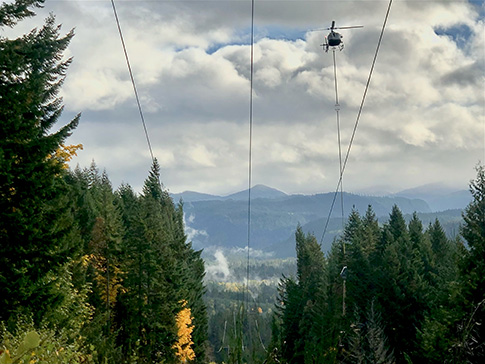Related News
Related News
-
EWEB secures $2.5 billion of reliable, affordable, carbon-free energy for customers
The new contract with EWEB’s largest energy supplier, the Bonneville Power Administration, forms the foundation of a diverse energy portfolio.
Find Out More -
Women in STEM: Meet the Hydro Project Engineer Building Habitat for Salmon
EWEB Engineer Associate Val Chang found her way to the McKenzie River from Los Angeles, inspired by heritage trips to the waters of Taiwan and key mentors along the way.
Find Out More -
Public Power Week Poster Contest Winners 2025
The results are in! View the winning posters from EWEB's 2025 Public Power Week Poster Contest.
Find Out More -
EWEB Hometown Heroes compete internationally
Out of 290 teams from 14 different countries, EWEB's Lineman Rodeo team places in the top third of competitors.
Find Out More -
Let's Talk Turkey. Is your family ready for winter?
We're heading into the holidays, but that also means snow, ice, and not-so-nice weather might be in the forecast. Here are some tips to prepare in advance.
Find Out More -
Vote for your favorite Public Power Week Posters
The top five submittals will receive awards. Help us pick the winners.
Find Out More -
EWEB Partners with Eugene School District 4J to Celebrate New Kennedy Middle School Emergency Water Station Site
Hundreds of attendees practiced filling up water containers at Saturday's demonstration event.
Find Out More -
Electric Projects underway in North & South Eugene
Underground lines and disaster-resilient power poles are part of EWEB’s infrastructure upgrade near Eugene’s largest natural resource area.
Find Out More -
The Bonneville Power Administration Rate Change and Your EWEB Bill
BPA’s finalized rate increase is smaller than projected, and EWEB’s pass-through adjustment effective October 1, 2025 will now be 2.7% for residential customers—down from the anticipated 4%.
Find Out More -
Join the Pledge to Prepare
When you think about getting ready for an emergency, you probably have questions. You aren't alone. Preparing for emergencies can be overwhelming, which is why EWEB has put together a 12-month program to help you and your family get two weeks ready.
Find Out More -
You can’t predict the next disaster, but you can prepare
The earthquake lasted less than a minute. But now the power’s out. The tap runs dry. Cell service is spotty. Would you be ready?
Find Out More -
EWEB completes helicopter installation of salmon habitat features
EWEB adds downed trees and 2,000 tons of gravel to the Uupper McKenzie River below Tamolitch Falls to improve spawning habitat.
Find Out More -
Court rules in favor of EWEB in Carmen-Smith litigation
The U.S. District Court in Eugene has granted EWEB's motion to dismiss a lawsuit brought under the Endangered Species Act pertaining to fish passage at EWEB’s Trail Bridge Dam. The favorable ruling clears the way for EWEB to continue advancing towards implementation of permanent fish passage at the dam.
Find Out More -
EWEB proposes modified plan for permanent fish passage at Trail Bridge Dam
After eight months of extensive collaboration and analysis with scientific experts at two federal regulatory agencies, EWEB is proposing an improved plan to build permanent fish passage facilities at Trail Bridge Dam on the McKenzie River.
Find Out More -
EWEB prepares for wildfire season with risk mitigation measures
EWEB is building a more resilient electric system to weather various types of disasters, from wildfire to winter storms.
Find Out More - Show More
EWEB Brings in Helicopter to Trim Trees
November 04, 2021

Just as high winds with gusts of more than 30 mph arrived in the Oregon Cascades early Thursday, EWEB has completed aerial trimming around its Carmen-Smith transmission line using a helicopter with saw attachments to trim branches and treetops.
The trimming protects power lines from trees and branches during wind and snow storms, increases reliability and mitigates the potential for wildfires during the summer months.
The Carmen-Smith transmission line is a vital connection to EWEB's electric distribution system and the Bonneville Power Administration's transmission system. The line allows generation from the Carmen project to get onto EWEB's system and serve customers in Eugene and the McKenzie River Valley, or onto BPA's transmission network to be marketed to electric utilities across the West.
Carmen-Smith, about 70 miles east of Eugene on the upper McKenzie River, is EWEB's largest utility-owned generation source and can power more than 16,000 homes.
By using a helicopter, EWEB was able to limit ground disturbances in the 17-mile-long transmission corridor, which runs through the Willamette National Forest. Aerial trimming provides easier access to trees in remote, mountainous terrain that is difficult for tree crews and their equipment to traverse.
The aerial trimming is quicker, more efficient and less expensive than using ground crews.
EWEB estimates it would take three tree crews 2.5 years and cost eight times more to trim along its Carmen-Smith line using ground crews due to seasonal wildlife species protection limitations, fire season work restrictions and the inaccessibility of the terrain, said EWEB utility Forester Nate Alexander.
"And tying up three crews for that long would take them away from other important work in town the in the McKenzie Valley," Nate said. He added that not only was the company the low bidder, but it also had the best safety record, "so it worked out really well for us."
Wright Tree Service, EWEB's vegetation management contractor, trims about 300 "line" miles each year, in addition to another 250 "line" miles in areas at greater risk for wildfire.
Heli-Dunn, based in Medford, was the low-bidder on the contract and won the $125,000 job. The company uses two primary tools: A vertical shaft with eight, 30-inch-diameter saw blades attached to it to trim horizontal branches, and a tree-topper that uses two hydraulic grappling claws to hold the tree while a chainsaw blade does the cutting.

"The topper is great for handling fire-damaged trees," Alexander said. "It can cut up to at least 24-inch (diameter) treetops."

By using a helicopter, EWEB was able to complete the work in about seven days. Heli-Dunn worked mostly afternoons in late October to avoid morning fog, Alexander said. The company completed the job - trimming about 12.5 miles of the 17-mile transmission line - on Oct. 25.
EWEB is likely to employ the less expensive and faster aerial trimming in other areas of its service territory in the future. And with climate change bringing hotter, drier summers and longer and more intense wildfire seasons that limit when ground crews can prune, aerial trimming will become more popular.

